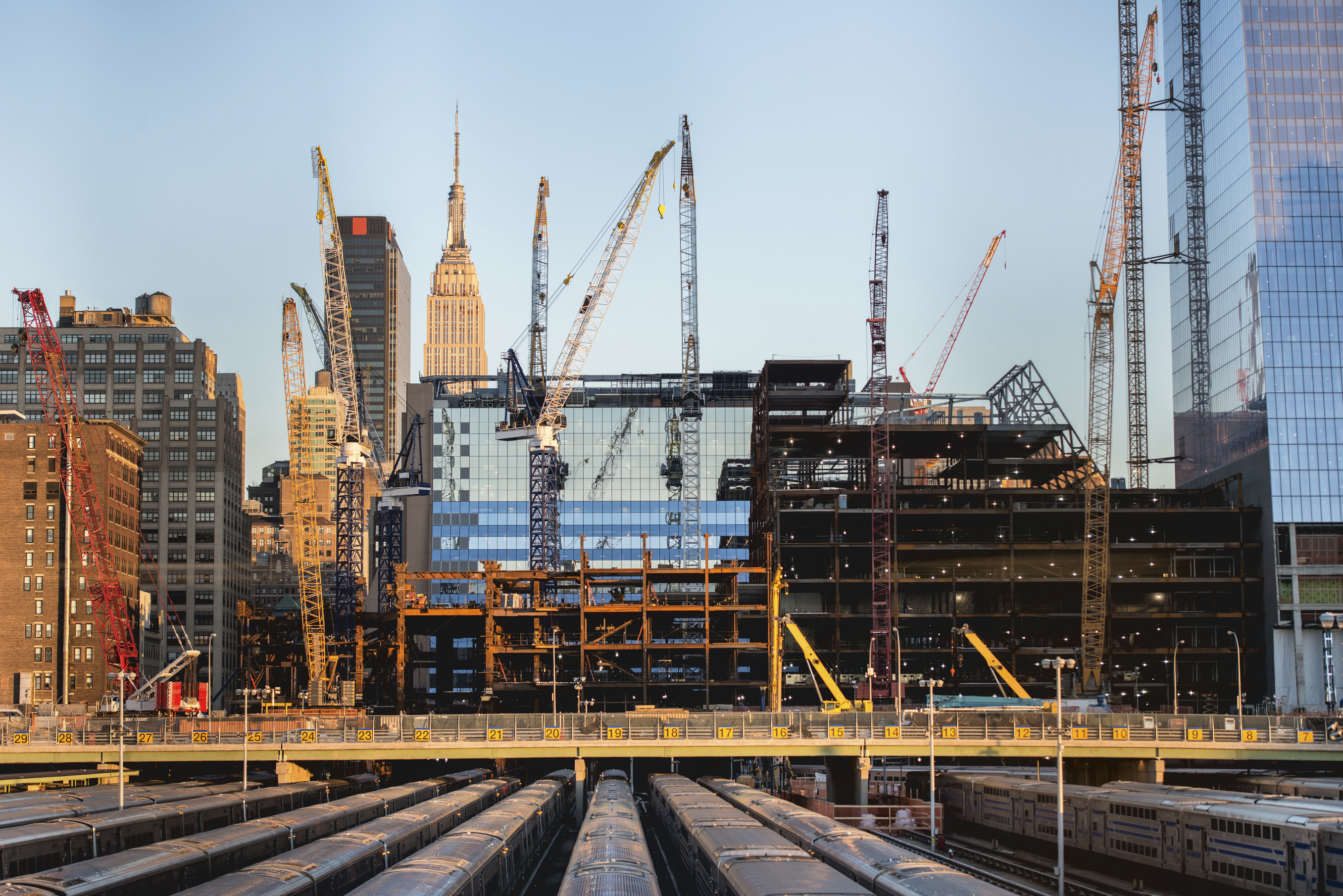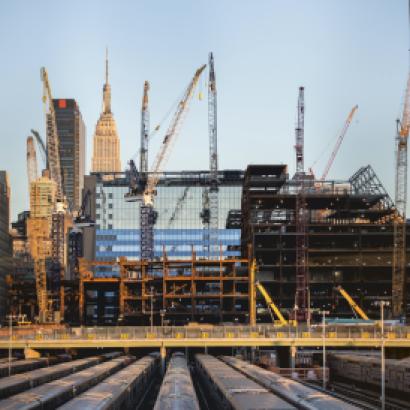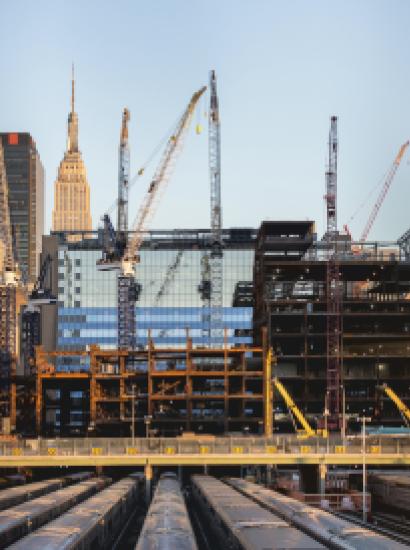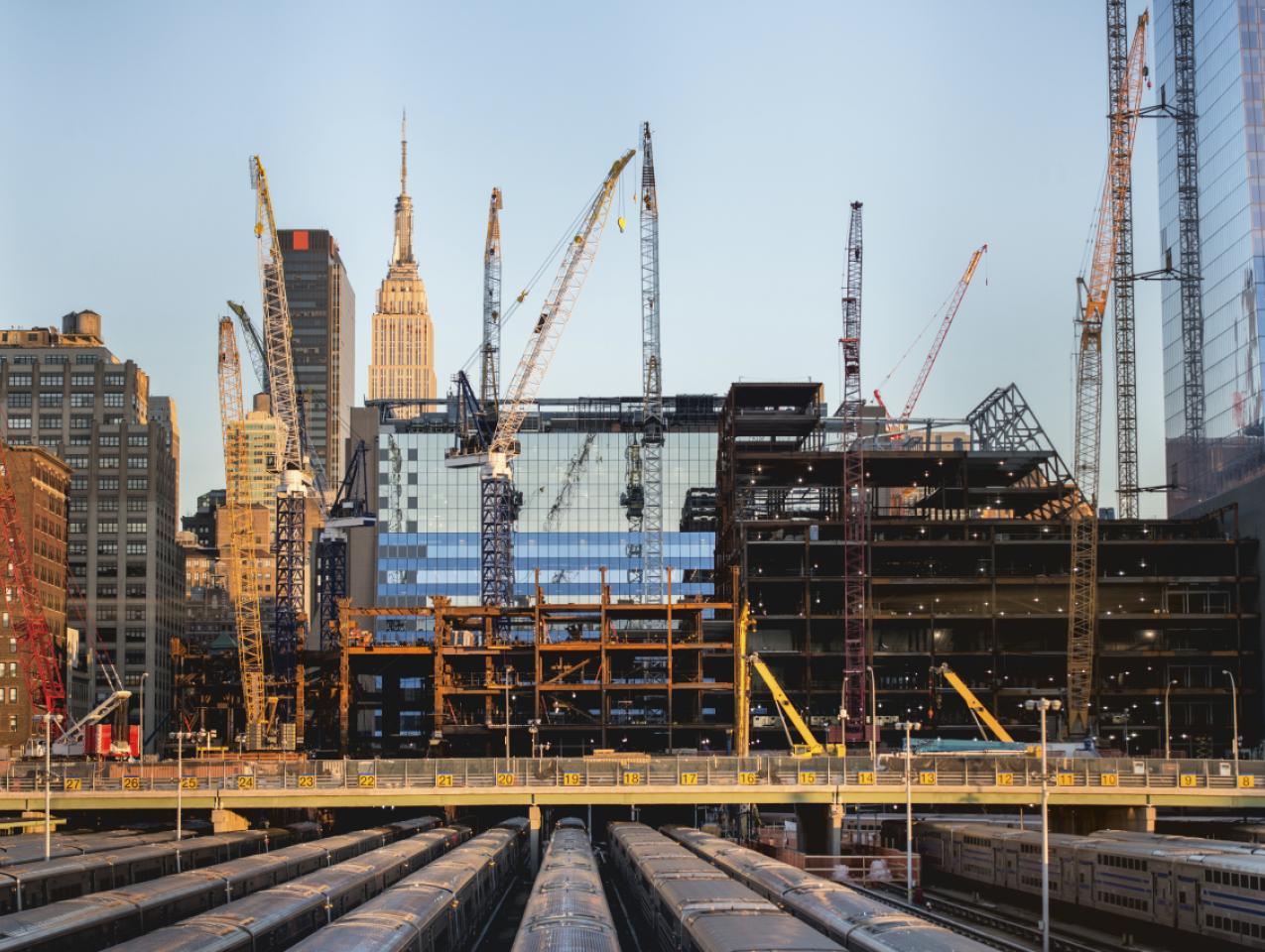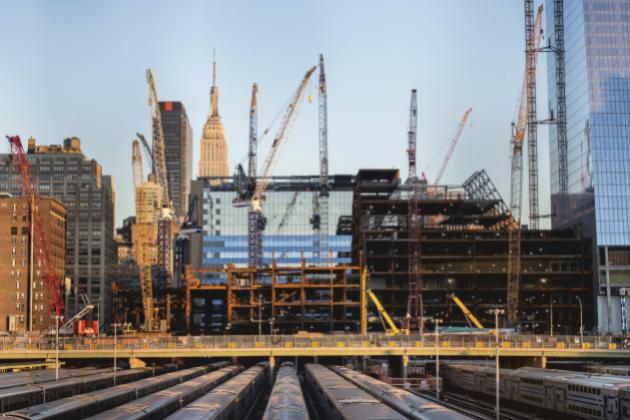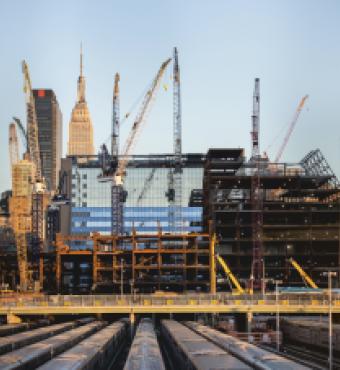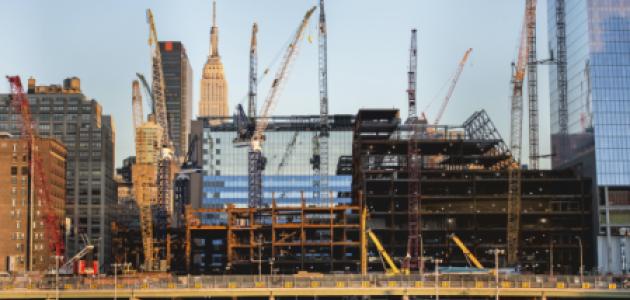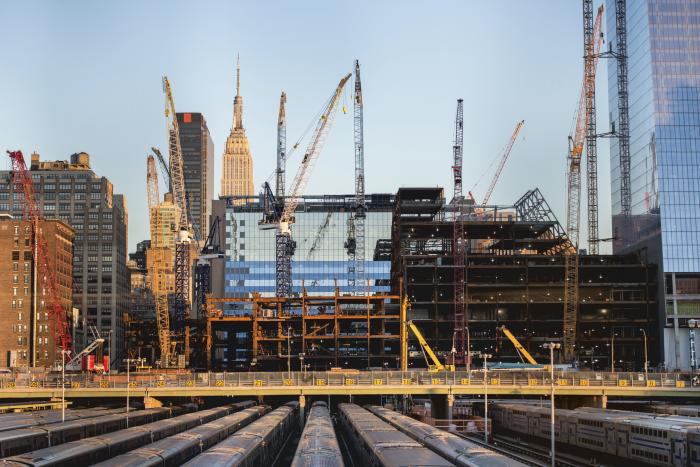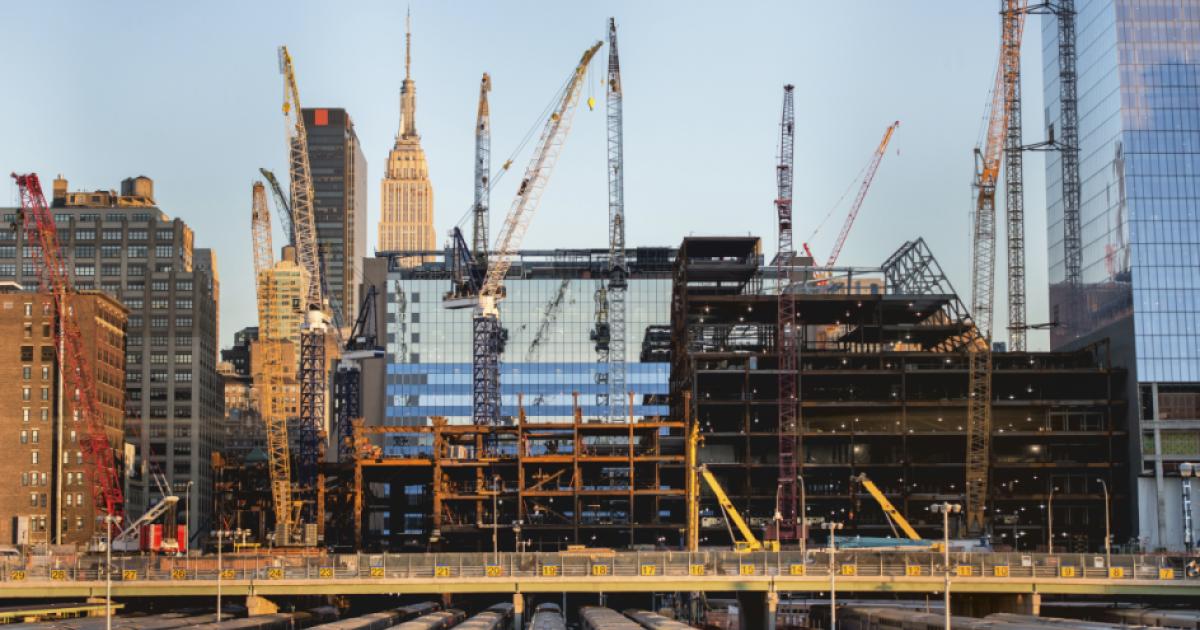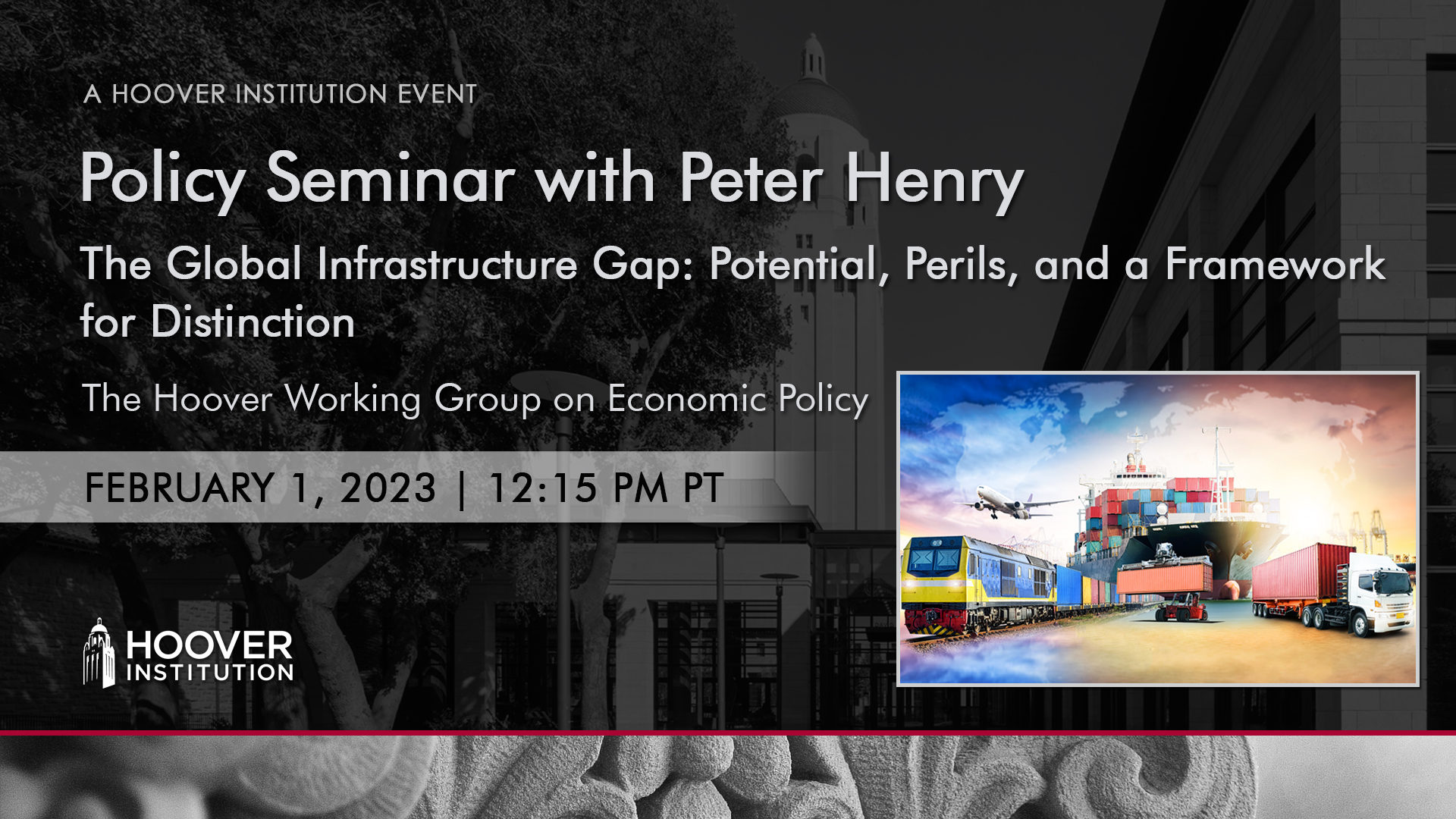PARTICIPANTS
Peter Henry, John Taylor, Richard Anderson, Peter Blair, Valentin Bolotnyy, Michael Boskin, David Brady, Tom Church, John Cochrane, Chris Dauer, Steve Davis, Christopher Erceg, Dino Falaschetti, Shana Farley, Precious Fasakin, David Fedor, Andy Filardo, Camille Gardner, Oliver Giesecke, John Gunn, Laurie Hodrick, Robert Hodrick, Nicholas Hope, Morris Kleiner, Pete Klenow, Donald Koch, Evan Koenig, Steven Koonin, Roman Kräussl, Mickey Levy, John Lipsky, Dinsha Mistree, Ashoka Mody, David Mulford, David Papell, Elena Pastorino, Paul Peterson, Greg Rosston, John Shoven, Tom Stephenson, Christine Strong, Jack Tatom, Jose Ursua, Eric Wakin, Gavin Wright
ISSUES DISCUSSED
Peter B. Henry, the Class of 1984 Senior Fellow at the Hoover Institution and senior fellow at Stanford’s Freeman Spogli Institute for International Studies (FSI), gave a policy seminar on “The Global Infrastructure Gap: Potential, Perils, and a Framework for Distinction,” a paper with Camille Gardner.
John Taylor, the Mary and Robert Raymond Professor of Economics at Stanford University and the George P. Shultz Senior Fellow in Economics at the Hoover Institution, was the moderator.
To read the paper, click here
To read the slides, click here
WATCH THE SEMINAR
Topic: The Global Infrastructure Gap: Potential, Perils, and a Framework for Distinction
Start Time: February 1, 2023, 12:15 PM PT
>> John Taylor: Really happy to have Peter Henry back to the best place of all after a sojourn in New York City and back, I understand you were here 13 years and then eleven in New York. So it's great to be back and just the beginning of many good things to come again so thank you, Peter.
But this is a joint paper with Camille Gardner, and it's called the Global Infrastructure Gap, colon potential perils and a framework for distinction so it's a great title. But one thing, maybe you could say a little bit about this excellence initiative we don't know anything about it. If you have any time during your talk, beginning or whatever, and I see you have a colleague who knows a lot about it.
Okay, yeah. Thank you.
>> Peter Henry: Thank you, John is some really.
>> John Taylor: We have people who are external, so they're part of the group.
>> Peter Henry: All those who are on screen and here in person it's really terrific to be, to be having the chance to talk to this group so thank you, John, for that introduction.
So, as John said, this is joint work with Camille Gardner, who's a graduate of a program I run called the PhD Excellence Initiative so just a word about that. The PhD Excellence Initiative is a Sloan foundation slash Hoover funded initiative it's a post bat program whose goal is to increase the number of underrepresented us minorities in PhD programs in economics.
So Camille Garner is currently a student at Brown University in her third year of her PhD program. We have in the room precious Versakin, who is the second year of her fellowship, and she's in the midst of waiting to hear from graduate school, does work on political economy and African development.
So that's the PhD excellence initiative so really thrilled to talk to you today about this paper, the Global Infrastructure Gap. So this paper is motivated by two facts, right? So fact number one is that, and please jump in at any time, ask questions. I'm sure I don't have to say that in a group of economists, but just in case this is a shy group, I'll go ahead and say that.
So the first fact that in poor countries there are 1.2 billion people have no electricity, another billion people who do not live within 2 kilometers of an all weather, all season road, as documented by Rozenberg and Fay in their World Bank book of 2019, and also in many other places.
And just to give you a sense of the low ratio of infrastructure capital per capita in the developing world relative to the advanced world, Latin America is roughly one fourth the infrastructure capital per capita of North America. Emerging Asia has one fifth the infrastructure capital per capita of advanced Asia and the 48 countries of sub -Saharan Africa produce about as much electricity as all of Spain so this is a fact.
There's a lot less there's a lot less infrastructure services in poor countries. Fact number two that motivates the paper is that in April 2015, the World bank claimed that by moving from billions to trillions of infrastructure investment in poor countries, that rich country private capital could do three things.
One, they could close the infrastructure services gap, which is an allusion to this sort of just shortage of infrastructure capital per capita that I mentioned before. Two, achieve the sustainable development goals so just think about the energy transition that's currently underway as part of the SDGS. And three, make money, right?
So the World bank makes this threefold claim, and they kind of launched this call to action from billions to trillions and in addition to the World bank, the IMF and the various development banks were part of this, this initiative, and they issued a communique. So those are the two facts that motivate the paper.
So we wanna ask a very simple question. Is it true that poor countries have widespread potential for publicly efficient and privately profitable investment infrastructure? Because if you think of the World Bank's claim, the World Bank's claim really boils down to to this. You can do well and do good by moving more infrastructure investment into poor countries so this is a question we try to answer in this paper.
So if you look out in the world and see what other people think the answer to this question is, the answer is yes if you look at the McKinsey Global Institute. So in 2016, the McKinsey Global Institute, this is sort of what McKinsey does best in some ways they sort of seized on this communicate the World bank issued in 2015 and launched a report which basically coined this phrase, the infrastructure gap.
So what did McKinsey do? McKinsey basically said the following thing. If we look at projections of global GDP growth, which at the time, we're roughly 3.5% per year, and do some, let's call them back in the envelope calculations to estimate how much infrastructure would be needed, just thinking that it's given, and then look at the following number.
So you can actually get projections of global infrastructure spending. I forget the exact name of the publication it's signed to someplace in the paper. And so they just aggregated up what projected infrastructure spending was versus what it would need to be in order to achieve a 3.5% growth rate, and said, the second number.
What's projected on infrastructure spending is shy of what's needed by about a trillion dollars a year. And they said there's a trillion dollar a year infrastructure investment gap. Lots of challenges with that, which I'm going to talk about but in this room, I think it's pretty obvious what the challenges are.
But to the broader world, yes, there's a trillion dollar infrastructure gap, John, and then some first thing.
>> John Taylor: In that question, are we holding constant or not the country's political and economic institutions? Cuz I can easily see that if India could import American institutions now, it's profitable. There's no reason they shouldn't look like Texas.
And if they don't, it's not profitable for the obvious reasons it's not profitable.
>> Peter Henry: Yeah, so when we actually look at the data, we're gonna look at some data on estimates of the social rate of return infrastructure. Those estimates we take from, kind of shockingly, the only paper we could find a, that exists that's actually done this exercise.
And the shorter answer is that the paper was written by David Canning, who's an economist at Harvard School of Public Health with a deceased co author. And in their paper, they try to do what you just suggested they try to estimate the, essentially the elasticity of output respect, infrastructure, taking into consideration levels of human capital and taking, implicitly, institutions as given.
So basically, they kind of control for the kind of the stuff that Lucas is worried about and say, given all that, what's the best we can do in terms of estimating the elasticities? And I'm gonna talk about those numbers they produce some numbers. Which I think actually largely reflects your concern, which is that infrastructure returns aren't so high everywhere.
That's really the punchline. But I'm going to
>> Peter Henry: Yeah, so I'm gonna get to that. Yes?
>> Elena: We had a similar follow-up question. There was do you think about potential in terms of share expenditure, differential in expenditure and infrastructure, or you're thinking about net rate of returns? But then you have to take into account the various vintages and the profitability of the vintages and the feasibility of their operation?
I looked at Latin American countries and a lot of very advanced equipment for farming that has been heavily subsidized by the World Bank ended up not being used because spare replacement parts not available. A lot of the farming and workers were not able to operate themselves and support.
So, how do you factor this consideration in your calculation?
>> Peter Henry: So hold that thought until I tell you about the data, right? So I think both your comment and John's comment are going to reinforce, let's say, skepticism. But the framework that we produce and the data that we feed through it are going to give us a very kind of cautionary tale, or caution saying that there's, the World Bank really overstated the case here.
And our message is that we're showing you why that's the case. I think, most importantly, what we're gonna do is actually give a framework for actually think about how would you even approach this question, right. But I think both your question and John's question are going to lean in the direction of reinforcing our message of Franklin conservatism.
>> Elena: Unless you're looking for bounds like enough and a lower bound on potential returns.
>> Peter Henry: Yeah, so
>> Elena: And that's informative already.
>> Peter Henry: Yeah, so we're gonna get there. So hold that thought. So I told you about McKinsey. Not to be outdone, the JP Morgan Development Finance Institute, just before the pandemic hit, JP Morgan announced and sort of launched this development finances with the idea in mind of, you guessed it, kind of filling this global infrastructure.
And most recently the White House in June 2022 issued. You can find the memorandum, it's on the website, White House website. It's a partnership for Global Infrastructure Investment, which is again, kind of quotes, this global infrastructure gap and is kind of a follow-up on the Build-Back Better World Initiative from 2021.
Which is again geared, essentially trying to sort of find a counterbalance to China's kind of Belt and Road initiative. And by the way, it's not just the Biden White House. In the Trump White House, I attended a virtual seminar in December of 2020 as they were on their way out, quoting the same kind of global infrastructure gap numbers.
My point here is that there are a lot of serious institutions, from the White House to McKinsey Global Institute to people who are actually allocating private capital, that are using this framework as a way of driving their thinking about this question.
>> John Taylor: So in the same sense, the way it's stated, you say what is wrong with this framework is people.
People are where they are. Yes, there's different forms of government differences, but yes, they can catch up. Otherwise, why do foreign aid at all? It seems there's whole presumption here is a yes.
>> Peter Henry: So, right. So you're right, so what are the concerns? So the concerns are that the notions of a global infrastructure gap and needed investment there an unfortunate similarity to the financing gap, which I'm sure a few folks in the room will remember.
This idea of the financing gap of Herod and Domar, right? So just a kind of quick reminder, like the MGI conception, the Harrod Domar model basically asserts that, let's say there's a desired target level of growth you wanna hit, make up the number 5%. I can see Nicole smiling.
He remembers this, right, video. Okay, you then say, given national savings target investment applies to financing gap equal to the difference between two quantities. And armed with this framework, this was the MO of the World Bank in the 1950s, right?
>> Peter Henry: So rich countries sought to help poor countries grow by filling the financing gap, right?
And to quote Bill Easterly, they failed, right? They failed because they didn't ask the question, which I'm sure almost everyone in the room is asking. Well, you have to ask the question, whether filling this needed investment gap would actually correct some market failure, incentivize production, given institutions, as John mentioned, so forth, incentivize production indigenously, raise incomes.
So all we're gonna do is paper is just, we're gonna take equilibrium seriously. But before I do that, let me just a little more motivation in the data to say, okay, well, more broadly, why should we care? We should care because if you think about whether it's the partnership with global infrastructure investment, China's built-in road initiative, or all the thinking that's currently going on about financing this green transition and so forth.
There are big opportunities, but there's also opportunity for peril. And just as a reminder, what's the potential peril? So pay attention to the green line and the blue line. The blue line is the average annual growth rate across all emerging economies of growth in the stock of public capital.
So think of it as a proxy for infrastructure. These numbers come from the IMF. And the green line is the annual percentage growth rate of productivity, again, average across. And this is a very simple point, was if you look at the developing world in the 1970s, there was a rapid acceleration of investment in public capital that coincided with, if you remember, teachers were teaching about the third world debt crisis.
There was an oil surplus in the 70s, got recycled. There's lots of capital that flowed to developing countries, a lot of it got invested in public capital. And the productivity gains that we'd like to see coming from infrastructure didn't happen. And we know the outcome of that story was the third world debt crisis.
So, the point is, if we kind of go back to, hi, John, nice to see you. If you go back to this kind of thinking again, there's a potential for basically Deja vu all over again, right? And so I'm thinking here, Ken Rogoff, is this piece of the third world debt crisis I've mentioned easterly?
I think very importantly, though, even before COVID hit. So if you think about the current environment, so Ghana's defaulted on its debt. Zambia defaulted, I think, in 2020 or 2021. You may know about the case of Sri Lanka having this Hambotoa port that was financed by the Chinese got seized because Sri Lankans couldn't service the debt.
Even before COVID hit Landry Signe, who's at Brookings Carmen Reinhart and co-authors and Gallagher and Ray, who run this center on Chinese capital flows, the developing world at Boston University, were warning about high debt in poor countries and potential for default. And so we're seeing that play out.
And the point is that this is not just a COVID effect. The seeds for this potential kind of Deja vu all over again, planted even before COVID hit. So and again, kind of just sort of this naive sort of gap thinking is at the root of at least some of it.
>> John Taylor: Peter, do you think the answer to your big question of whether this investment can be profitable and also good for the receiving country? Does it depend on, is it the answer different if the funding is coming from China versus the West?
>> Peter Henry: I think the answer is yes, and here's why.
I think it's exactly the right question. So it all depends, do you have a model in your head of why it is you're channeling council, right? So if we kind of think back to kind of the rationale behind the Bretton woods institutions, all of them, the World Bank, the IMF, even the WTO, right?
Is very simple. We wanna think about a world in which capital flows from country X to country Y and Z, and every letter in between are motivated by trying to maximize global welfare, right? And as a proxy for that, think about maximizing global growth, okay? If the model that you have in your head for allocating capital to poor countries is politically driven, then you have to think for a very long time to realize you probably are gonna get different outcomes.
And so we're not saying this. We say this sort of very politely in the paper. But if you're not being driven by this model of maximizing global welfare, it's not surprising that you're gonna have these kinds of outcomes. And so part of the motivation is if we actually wanna think about how to bring about kind of welfare maximizing outcomes, frankly, need some leadership to sort of say.
This is the way which we should be thinking about global capital flows, particularly the spectre infrastructure. The paper's not a normative paper, but that normative message is lurking not too far from the surface, John.
>> John Taylor: You mentioned impediments, which you need to. George turns to Milton and says, milton is a $20 bill on the sidewalk.
Milton says, it couldn't be that the market would have picked it up. But if the claim that it's high marginal product and privately profitable, then you kind of got to ask, why do we have to do this? Why hasn't it happened?
>> Peter Henry: So the first question is, are there instances?
Are there places in the world where that claim is actually true? And then with this-
>> John Taylor: What's the barrier?
>> Peter Henry: Yeah, and section six of the paper. As you say, I'm not gonna talk about all the paper today cuz it's a long paper. It's forthcoming in the JL.
But I just wanna hit the high points. You can kind of go back and read what really particularly interests you. Section six of the paper is called frozen capital, which is basically kind of getting at this point, John, which is if you think about those places of the world where the opportunities do exist, but they're not actually being taken advantage of, why is that?
But I'll say a little bit more about that when we get there. All right, so I have most of the message in paper, but let me just sort of get to walk you through a liberal logic. So this paper can do something very, very straightforward, and we're gonna introduce a simple equilibrium framework that distinguishes those four countries in which the bank's threefold claim is tenable from those where it is not.
So John Taylor and I were talking about Econ One before we walked in, and this is really, it's sort of Econ One. I try, as best we can tell from looking at the literature, just some basic kind of first principles that haven't been applied to this set of questions.
And so we're gonna do that in this paper. And we're gonna call our framework dual hurdle framework. And we're gonna call it the dual hurdle framework, as you'll see in a second, because we're gonna ask two questions about hurdle rates. We're gonna say, what's the hurdle rate for thinking about efficient investment in infrastructure from a poor country's point of view, in terms of whether you invested a dollar in private capital versus public capital.
So it's gonna be one hurdle rate. And then we're gonna think about a second hurdle rate, which is to say, if you're a pension fund or investment manager in rich countries and you're thinking about allocating a dollar of savings. Versus in some place in the US privately versus investing in public capital in the developing world, there's gonna be another hurdle rate that you're gonna have to consider.
And so once we put in place these two dual-hurdles, we're gonna see that it clarifies thinking pretty quickly about whether the World Bank's right or wrong. And the main kind of the message that comes out is that the dual-hurdle provides a practical tool for setting infrastructure priorities. Seem to tell us where the World Banks claim is true, where it isn't true.
But more generally, this way of just thinking about hurdle rates is gonna apply within countries to think about. You could use it to think about roads versus electricity, schools versus roads. It basically just provides discipline for thinking about where investments in infrastructure are gonna be socially efficient versus not socially efficient.
And applies within countries as well as it does to the kind of the cross country analysis we're gonna do here. And I think the most important message really that or finding that comes out of this paper, is the kind of paucity of data that's publicly available right now for actually applying the dual-hurdle framework.
So, in other words, the World Bank makes this claim in 2015 about going for billions to trillions in infrastructure. And they do it, as we're gonna see, as I take you through the paper watch on the basis of no data whatsoever, to be frank. It turns out the world back when they made this claim, they had actually commissioned a paper in the year 2000 that estimated social rates of return across countries, which you could have used to apply the dual-hurdle framework.
We actually do that, but the World Bank doesn't reference this paper at all. They make no reference to any social rates in return, which to us is kind of stunning, frankly. But most importantly, given that these are knowable facts right there into. I didn't get your name.
>> Elena: Elena.
>> Peter Henry: Elena. Elena's point, estimating social rates of return really depends on assumptions you make about things like maintenance. And the social rates of return that were estimated in this World Bank white paper in 2000 were based on data from 1985. So these data are really old, but the World Bank should be in the business of basically updating this data independently, validating it.
So that people can actually have information on which to sort of have a serious debate about what these returns look like. How big are the gaps in returns between rich and poor countries, and begin to think about whether these are opportunities worth pursuing without the data. It's really a conversation in the dark.
Yes, Peter and then Steve and someone online as well.
>> Elena: Michael.
>> Peter Henry: Go ahead, Michael. Well, sorry, Michael, then Peter, then we'll come back. Go ahead, Michael.
>> Michael Boskin: So there's a lot of evidence in advanced economies that rates of return on infrastructure are very modest. The CBO estimates they're well below private rates of return, number one.
Number two, that the highest rates of return on repair and maintenance, that makes more sense. Perhaps in a more developed infrastructure economy that diminishing turns are set in. There's not a lot of extra interstate highway you can build. We're not gonna build a highway to Hawaii. So in any event, then there are all the political economy complexities in the United States.
Which I'm sure are more extreme in many developing countries, regional tribal political differences, graph corruption, exchange rate constraints. Which drive wedges between in cost benefit analyses, etc. And so I'm just wondering if we're thinking about the basic idea of the rates of return being relatively low in advance.
Perhaps being potentially somewhat high, at least if they can be organized and implemented in a way that isn't overly politicized, that drains away the social returns. I'm wondering what we can learn from the history, infrastructure development in advanced economies that might be applicable, if not the current events that might be applicable and things to avoid.
And are you looking at those kinds of things in potential valuable place to look for insights into all these?
>> Peter Henry: The answer to your question is, yes Michael, the point about the modest rates of return on infrastructure in advanced economies is central to this picture that I'm about to describe, right?
And so to your point there's a paper by John Furle in the AER in the early 2000s. Which basically demonstrated what you just said, which is that building an interstate highway system generated large social benefits. But subsequent to building the interstate highway system, there's not much evidence to suggest that there's continuing kinda growth benefits from investing in roads.
And more generally, what we find when we actually look at the data that was produced on social rates of return by canning and benathen is that in general. The rate of return on public, on infrastructure, on roads in particular, in advanced economies, is generally below the rate of return on private capital.
So why that matters is that when you're thinking about the incentive for capital flow from rich to poor countries, basically the comparison between the relevant benchmark. The binding constraints for private investors in rich countries is not whether they should be investing in public capital in rich countries. Because the rate of return is generally lower than the return of the S&P 500.
It's whether the rate of return on public capital in poor countries exceeds the rate of return on private capital in rich countries. So that's sort of point number one. I'm gonna talk about that analytically in a second. Point number two, your question about are there things we can learn about the political economy of infrastructure investment in rich countries?
I think it's a great point. We don't have a lot to say about that in this paper, but we think that our findings would suggest that there are some opportunities potentially in poor countries. We gotta be very careful about it. And the way you want to think about how to actually bringing those to fruition, I think probably can be informed by what's happened in rich countries, Peter.
>> Peter: When you talk about the dual hurdle test, are you gonna put in place a mapping between these hurdles. And then the potential frictions that we think might be responsible for the reason for which there isn't as much capital flows?
>> Peter Henry: Yeah, first I'm gonna just talk about the hurdles.
>> Peter: Okay, I'll wait then.
>> Peter Henry: And then in the section I'll lead to the section of frozen capital is all about. This is John's question. If there are big gaps, why don't we see the flows? And I'll come to that. Elena was next and I'm losing. And then Steve and then Ross.
>> Elena: We're thinking in marginal terms about rate of returns when I'm thinking about the cost structure. Now imagine I'm trivializing the infrastructure choice problem as a capital adjustment problem. And I think about the standard SSS, shape of can arrow, etc. And so I'm thinking, well, it could be that the minimal feasible, so to speak, meaning privately optimal, not thinking about network effects, Investment in infrastructure capacity is high enough for reasonable return to kick in.
That it may be too much, so to speak, for the prototypical underdeveloped country to be able to do so, to convince international institutions to support it, etc. So it could be just a very simple story that you need a minimum capacity to really invest efficiently. And at that level the rate of return calculation kicks in.
And so I wonder if you have any sense of that this story, standard story or non concavities or local convexities could be.
>> Peter Henry: I don't think we're able to speak directly to that question in the paper, but I think the orders of magnitude that we're gonna show, I think will be illustrative.
So a little more patience, we're gonna-
>> Elena: Sorry, hold on, what do you think about the work of Dave Donaldson and other MIT? In fact, it shows you that electrification, when infrastructure doesn't require a lot of. Well, that requires some capacity, but there are clearly vast economies of scale to support it.
That's where some of this investment have been.
>> Peter Henry: Yeah, we allude to today's work in the paper, and Donaldson is for Indian railroads. And we're trying to do it. We're gonna look at this question for basically for 53 countries.
>> Elena: Okay.
>> Peter Henry: So that's through a framework, Steve.
>> Steve: It'd be something to replicate Donaldson's work for 53 countries.
>> Peter Henry: No, we're not reveling.
>> Steve: Can you just clarify what's in your concept of the social return? So is it just things that ultimately show up in GDP in the near medium term? So it doesn't include, for example, if we build a road network in a rural, underdeveloped region with no roads.
That there's going to presumably be some positive benefits on health outcomes, especially for children and maybe better education. Those are things that will manifest themselves in GDP way down the road.
>> Peter Henry: Yes.
>> Steve: So that's not in social return.
>> Peter Henry: That's right.
>> Steve: Okay.
>> Peter Henry: So once critique for instance, that Valerie Ramey had of the paper, which.
I sent it to her, is if you think about rural electrification, the one thing we're gonna find is that the results for electricity are much weaker than they are for roads. And so, we just give no way of saying anything about it with what we've got. Our point is, don't overstate how low the returns might be because to your point, if there are things that aren't show up in GDP or if there's a particularly long lag between, say, electrification and GDP benefits, you're missing that.
And that's absolutely true.
>> Steve: Okay, do we have high quality evidence on how building a road network affects child mortality, for example?
>> Peter Henry: I've not seen those yet. So, I think the way to think about your comment is to say, what are the reasons to be skeptical of our conservatism, right?
So if you believe that the externalities of infrastructure are understated and they're more generally the estimates that are trying to basically estimate GDP, the standard thing are missing important other factors, then yeah, you should be skeptical of what we're saying. So, we're really tying our hands to just the production function.
And letting Cunningham and Nathan do all their comments or tricks to get us the best conservative estimates. We could find, have social rates of current in the strictest kind of hamburger sense, right? And saying what do we see? And then we have a section of the paper where we look at Jones and Klenau and others to say, how wide are the confidence intervals around these kinds of estimates and other messages?
Be really careful, there's a lot of variation in the data. Right, and so we think that kind of reinforces our message of conservatism. But I totally open to the fact that you might say you guys are just maybe you're being too conservative.
>> John Taylor: Health shows up in GDP pretty fast in poor countries.
>> Peter Henry: Yeah.
>> John Taylor: A lot of people don't work cuz they're sick.
>> Peter Henry: No, but I'm thinking about.
>> John Taylor: Can I ask you one question, how much of infrastructure is auto related and truck related is probably huge?
>> Peter Henry: Yes, so-
>> John Taylor: Isn't there a question whether that's even gonna be replicated?
>> Peter Henry: The replicated what sense, John?
>> John Taylor: I can think about ten or 20 years, and you can have easily, auto is sort of a complex machine that's actually only used 4% of the time, right? And you can have a taxi service activated by cell phone or whatever in local areas.
And if you're gonna go on a vacation, you lease a car, and you could cut way back on the whole entire infrastructure. If you think of 1.4 billion people in India and putting a road structure in there, it's gonna be impossible.
>> Peter Henry: I see, that's a good question.
So the best I can do in answering your question is the estimates of the rates of return that we have in the paper. There are two types of infrastructure that can give an answer to the estimates on, electricity and roads. And so I don't think that their estimates are gonna speak very well to the future if I can interpret the spirit of your question.
But one of the things that we say in the paper is that, taking the estimates that we have, is given, and it turns out there's a lot of evidence that roads are the much higher return project in general in the developing world. But to your point, one thing we say here, we got to be very careful because you're trying to think about the roads you might build in the future, especially given that the data we have are from 1985, just when these estimates were done.
Those estimates are probably quite different than the rates of return you get today. And more generally, yesterday's roads may not be tomorrow's transportation network. So if you're thinking about how you'd want to think about the future, the point we make in the paper is there's some very interesting work by a guy named Sally angel, who's at NYU, who worked on cities.
And his point is that when you think about roads, the biggest return you can actually probably get on road infrastructure in developing countries is just laying a grid. Why do I say that? So it turns out that because of your point, we don't have a good sense of exactly whether we're have electric cars driving on roads or how many roads, how many cars we're gonna have.
But we do know that the grid that was laid in New York City made a pretty productive place because we've got right angles and there's urban space set off from green space and so forth. And so if you think about Ethiopia, right, which is gonna have 30 cities emerging over the course of the next 15 to 20 years.
What you wanna do is an anticipation of future urban development, basically lay down a grid, and that may be the high and just so having that grid laid out, maybe the highest return roads you can actually use, actually deciding whether it's gonna be asphalt or cement or so forth.
So I did say that's a pretty subtle answer to your question, but that's one of the things that when you actually step back and look at this framework and see what's going on in these places, you begin to really get a sense of how complicated the question is.
And what you really wanna do in that case is you wanna maximize your ability to option value in the future of how you'd actually build the road, given that you don't know what technology is gonna look like. So, I kind of got ahead of myself, but it's a great question.
Yeah, it's a great question. Okay, there's one other.
>> John Taylor: You can go ahead and answer.
>> Peter Henry: So let me talk about the framework in the last 20. Okay, so.
>> John Taylor: You got all questions.
>> Peter Henry: So, let's start with a thing about Lucas's 1990 AR paper, which basically is capitalism.
Why is the capital flow from rich to poor countries? And when you think about infrastructure, you got to ask, where does Lucas fit into all this? Well, it turns out that when Lucas wrote his paper in 1990, a couple of points to make. One, there were a lot of restrictions on capital flows in 1990.
And one of the hypotheses that Lucas put forth his paper is why countries. Which he kind of was a little bit dismissive about, was actually their barriers to capital flows. So it turns out when Lucas published his paper in 1990, probably wrote in 1989, shortly after Lucas published that paper, guess what?
Emerging economies lifted restrictions on capital inflows to developing countries. And it turns out a lot of capital did actually flow in the emerging economies, into their stock markets in particular, right? So Lucas wasn't completely right. There were some significant gaps between the return of private capital enriched in poor countries.
But the biggest point to remember today is that those returns have, largely on private capital, have largely been arbitraged away. That's sort of, I wrote my graduate school thesis about that. And if you actually look at the data, returns on equity portfolio, equity capital are pretty close now between the rich and poor countries.
But the important point about infrastructure, which follows from this paper by Lowe and co authors. Is that whereas the returns on private capital between rich and poor countries have largely converged. So Lucas is now right about that point. And this is what Casselli and others have made in their paper on the return to capital.
The potential welfare gains from private rich capital flowing to public poor capital are roughly 4.8 times larger than those from private rich to private poor. So in other words, this is going after Michael Boskin's point, because the rate of return on capital on public capital in rich countries is so modest.
There's really not much of an incentive for private capital in rich countries to invest in public capital in rich countries. But because there are large differentials potentially between public poor capital and private rich capital, that's what we really need to think about. And so what this diagram kind of outlines is that in order to think about this question of whether their benefit, whether significant welfare gains for private capital flowing from rich countries to public capital in poor countries.
Lucas's framework doesn't give you enough richness, because in Lucas's world, we just have a rich country to poor country and one type of capital K. So you can't really speak to this question of private versus public capital. So all we do in this diagram is just sort of lay out.
When you actually allow there to be two kinds of capital in two countries, there are a lot of permutations you need to think about. Bottom line is there are really two, only two margins that really are binding for the question we want to answer, for the World Bank.
And that is on number one, the question of whether our private poor is greater than our public poor or, sorry, whether our public poor is greater than our private poor. So what do we mean by our public poor? Our public poor is a rate of return on infrastructure in poor countries.
Our private poor is rated private capital in poor countries. So if not surprisingly, if the rate of return on public poor capital exceeds rate of return on private poor capital, then from a social. A welfare maximizing, social planners point of view, it makes sense to allocate the marginal dollar.
>> John Taylor: Just to make sure I'm not losing the thread here.
>> Peter Henry: Okay.
>> John Taylor: The statement on the slide is predicated on the view, which I'm not arguing with. But it's predicated on the view that a dollar's worth of extra GDP in a poor country has the same weight in the social planner's utility function as a dollar's worth of GDP in rich countries.
>> Peter Henry: That's right.
>> John Taylor: So that's an important maintained assumption, which makes perfect sense if you're looking at rates of return and what, where capital will flow. You may make a very different assumption when it comes to foreign aid decisions, for example.
>> Peter Henry: Yes, yeah.
>> Michael Boskin: Peter, some private capital, a fair amount in infrastructure is a byproduct of private, for example, energy exploration and development companies build complete railroads into the interior of Africa, etc.
So I'm wondering how you think of that relative to some portfolio manager with an international unit.
>> Peter Henry: Right.
>> Michael Boskin: Should we just lump them together? Should we distinguish that? And many of those countries either are for their own domestic workforce requirements or things imposed by the government, building schools, hospitals, stuff like that.
>> Peter Henry: Yeah, so let me come back to that question, Michael, cuz that gets to the point about how do we think about different kinds of infrastructure priorities.
>> Michael Boskin: Okay.
>> Peter Henry: And I think our framework is gonna have something to say about how you wanna rank order those, but let me just.
>> John Taylor: Let me take a moratorium on questions.
>> Michael Boskin: Sorry.
>> Peter Henry: No, it's a good question.
>> Michael Boskin: I'll be hopping on and off. I've gotta take one quick call. So if I missed your comment, I'll catch up later.
>> Peter Henry: Got it, okay, so taking Steve's point of the social planner.
It's a social planner. You're putting equal weight on growth everywhere and just trying to maximize overall growth. So talk about comparison number one. The other relevant comparison is going to be number two, the question of whether our public poor is greater than our private rich. We've talked about that.
So those are the two relevant hurdle rates. And with those relevant hurdle rates, we can just construct this very simple picture just to ask the question, where is it publicly efficient and privately profitable to invest in infrastructure? Okay, so let me just describe what's on the axis here.
So on the X-axis, we have the ratio of the rate of return on infrastructure, rx in the poor country. So that's our public poor, to the rate of return on private capital in the poor country, that's rK. That's so the couple thing, that's our private poor, right? And so what the logic just says is that if the ratio of the rate of return on infrastructure.
If the ratio of our public poor to our private poor is greater than one, it's efficient to invest in infrastructure in the poor country. So that says basic. So if you look at the vertical dashed line at one says that any, if you're to the right of that dashed line.
It's efficient to invest in infrastructure in the poor country from the point of view of a social planner in the poor country. And if we're trying to answer So that answers the question about is it publicly efficient from the perspective of the poor country? Now, if we want to ask the question, will there be any incentive for private capital to flow from rich countries into the poor country to invest in infrastructure?
And this is, I wanna be very clear, this is a necessary but not sufficient condition for private capital. But from the social welfare planner's point of view, the answer to that question is yes, if our public poor is greater than our private rich. So on the y-axis, we have the ratio of the ratio of r public poor to r private rich.
And so the horizontal dashed line at 1 that cuts across the y-axis at 1 says, if we're above if that ratio is above one, it's efficient to invest in infrastructure in the poor country for a private rich country capital point of view. And so what, the dual hurdle framework just says that the world kinda breaks into four quadrants when you just apply these very simple kind of equilibrium conditions, right?
So for a given type of infrastructure, let's say roads, okay? If it's the case that for roads in Kenya, the relative returns produce in quadrant one, then Kenya sort of satisfies kind of the World Bank's claim. And in the case of quadrant II, it's not the case, quadrant III, not the case, quadrant IV, not the case.
I'll just briefly say in quadrant II, someone asked a question about foreign aid. Countries that fall into quadrant II, by the way, in our sample of 53 countries, I'm gonna talk about, there's only one country that falls into quadrant II. The quadrant II is a quadrant where basically you can make a case for foreign aid.
Where basically you've got domestic efficiency but no incentive for private capital from rich countries to flow into the country, okay? So what we're gonna do in this paper-
>> John Taylor: I just wanna clarify.
>> Peter Henry: Yes.
>> John Taylor: Private capital goes in when the private rate of return is positive. But I think you're talking about the all in social rate of return.
>> Peter Henry: Yes, very important distinction, so we said take the perspective of the social plan and just say, where would it be kind of socially efficient global welfare point of view.
>> John Taylor: So that's gonna include all the externalities and all the other stuff.
>> Peter Henry: Yeah, exactly, so we're thinking of this as the most basic necessary condition for the World Bank's claims to be true.
Cuz if the public return in poor countries doesn't exceed the private turn risk. Yeah, exactly, you're exactly right, yes.
>> John Taylor: And even private capital can have externalities.
>> Peter Henry: Correct, all right, so what are we gonna do?
>> Elena: Also, modular risk. I'm thinking about the return differential in terms of not equity return puzzle.
>> Peter Henry: Yes, so the way to think of it, so again, we're not saying anything about risk yet, we just wanna take the data that are out there, put them through a dual hurdle framework, and say, where do we fall? Do any countries fall into quadrant I? And then what you wanna do at the end, at the very end here, I'm gonna talk about how we think about risk adjustment.
>> Elena: I see.
>> Peter Henry: Okay, because going back to John's point, if it's the case, if the difference between the social rate of return on public capital in Kenya is only 100 basis points higher than the private return in the US. Given all the risks that we've talked about in institutions and political factors, that necessary condition is clearly not gonna be enough in order to get calculated.
>> John Taylor: You're gonna give us the data?
>> Peter Henry: Yes, let me give you the data. Okay, so let's start with the data. All right, so we got this, we have a framework. And so we just asked the question, what data do we actually have on social rates of return?
Turns out, shockingly, I'd love to hear if someone's aware of all our estimates. But the only systematic estimates we found were this kind paper by Canning of Bennathan was commissioned by the World Bank. They do it for 53 countries, social rates return on paved roads and electricity generating capacity, so two types of infrastructure.
They also compute the rates of return on all capital. They have the same data for 16 rich countries. And a big caution, Elena mentioned this issue about costs. They can only do the estimates for 1985 cuz that's the year which they've got cost estimates for building roads and building electricity grids.
And obviously, costs have changed since 1985, technology has changed, lots of things have changed. So what we're seeing is taking the data is given. But just see what if the World Bank had even bothered actually look at their own data? What would they have found if they applied this framework?
>> Steve: This isn't data, how do you estimate the social return of a road in Bangladesh?
>> Peter Henry: Yes, so Canning and Bennathan have a whole paper on how they do this, is there basically what you're trying to, just very quickly, second, I'm not gonna do it justice in 30 seconds.
But you're trying to estimate the elasticity of output with respect to infrastructure, controlling for the level of human capital, the quantity of capital and control for reverse causality. And a whole range of other things that are-
>> John Taylor: Do they look across regions in Bangladesh, or how do they even begin to answer this question.
>> Peter Henry: Yeah, so I refer to their paper, it's an aggregate number. So they come up with one number for roads and one number for electricity for every country. So easy to say already you're talking about pretty heroic estimates, right? But there's an industry in doing this, they're careful about it.
And we have a lot of references to the paper to say why we think this is reasonable to take their workers together, okay? So 26 poor countries of data on roads, 48 on electricity. So basically that gives us 75 country infrastructure return observations of rho xk rho xk star, and we just confront these data with the dual framework.
Just plug them in and just sort of see, what do you see? So here's the bottom line, the comparison with the World Bank communicate. The joint prevalence of efficient, profitable opportunities is modest. So 21 out of 53 countries in the sample did not clear the dual hurdles for either roads or electricity, right?
So roughly 40% of the countries are just, there are no quadrant I opportunities in either type of infrastructure. Of the 32 countries with projects that cleared the dual hurdles, only roughly a fourth of the seventh cleared the dual hurdles in both roads and electricity. So the first order message is that quadrant I opportunities are not nearly as plentiful as a World Bank would have you believe or would like to us to think.
The reality that less than one-seventh of the countries presented a data-driven case for publicly efficient privately such a socially privately profitable was just a mouthful at input socially privately profitable. Investment raises questions about the wisdom of billions to trillions three decades later. In other words, the World Bank issued this communicate in 2015 without even having looked at these data, which are less sanguine than their communicator.
So let me tell you, just a little bit of orders of magnitude. All right, and you can read about in the paper. But the 75 observations, there were 39 quadrant I opportunities, 21 for roads, 18 for electricity. They were spread across 32 countries. Importantly, of the 21 quadrant I observations in roads.
The mean return was 10.2 times larger than the corresponding return on rich country capital. So in other words, it gets subject to how confident you are in the point estimates of these things, which you shouldn't be too confident. Because we've been kinda talking about. And we've a whole section of paper that sort of looks at how the heterogeneity in these things.
But just as a point of illustration, the point is that where there are quadrant opportunities, the differential can actually be quite large, right? So it's 10.2 times as large. The median is about six. For electricity, as I was saying before, the differentials are much smaller, about 2.2 times larger.
So let me say a little more about orders of magnitude. So how do we think about these orders.
>> John Taylor: There's a question. I could see a problem that Bangladesh is so poor that building a road, it could double their GDP. And that's worth about 10 bucks. And so building another road in Palo Alto, which raises our GDP by 2%, generates a whole lot more money.
Is that some of the units question?
>> Peter Henry: Yeah, except that also building the road pellets be a lot more expensive right? So that's presumably that comes out in the rates of return.
>> Peter Henry: But I think also an important point about your question, though, if you kinda go back to.
Sorry, go back to this estimate that Lowe and others produced, right? So what I didn't mention is that in their welfare calculation, they show that if the rates of return on public capital equalized across countries, that world GDP be about 9% higher. And your question's relevant there because world GDP would be 9% higher.
But that's world GDP, which is heavily skewed towards the rich countries, right? So the poor countries, the Delta, right? Relative, their baseline is probably quite large.
>> John Taylor: The same you ruled at the table which is where in the world do these numbers come from? Or if nobody has a car, building a road isn't gonna do you any good?
>> Peter Henry: Yeah.
>> John Taylor: Without the fundamental phenomenon.
>> Peter Henry: Yeah, that is the reason why. And again, we've more discussions in the paper. You gotta be really careful about thinking about these infrastructure return estimates, right? And implicitly Canning myth are picking that up in their estimates, right? Because they base these estimates on kind of incremental changes in kind of the number of kilometers of paved roads.
And they're looking at kinda the impact on GDP, all right? And so if to your point, no one's got a car, right? Or the institutions are just so poor that.
>> John Taylor: Bandits go on the roads.
>> Peter Henry: Bandits go on the roads, right?
>> Speaker 7: Whoops, there's bandits every time.
>> Peter Henry: Then you won't see any impact on GDP, right? So implicitly, it's picked up their estimates. And that's why, even though, having said that the road numbers are more promising than electricity numbers. But yes, that's the whole point of doing these elasticity calculations and getting these numbers. Let me say, before taking some requests, let me say a word about these orders of magnitude.
And why we think this is a useful way of approaching the question. So the ten x numbers that I mentioned before for roads, where you can think of that as the excess return on rows relative to the Kenneth estimate of the return on private capital in rich countries.
Another way to think about this is to say, okay. Let's think about the size of the excess return on roads relative to the excess return that existed on emerging market equity when these countries were actually closed off to foreign investment. Which is something I've thought a lot about.
So if you looked in 1985, when countries didn't really allow foreign investment in portfolio equity. The excess return on emerging stock markets, or, sorry, the expected return is measured by essentially the earnings price ratio was about 1.7 or 1.5 times as large as the expected return on the S and P 500, right?
And so what do we know? We know that once liberalization took place and we allowed companies like Dodge and Cox and others to invest in emerging market equity, all right? That 1.5 exit, for example, largely went away. And that 1.5 exit ratio, most importantly, that was large enough to basically fuel almost a trillion dollar industry now called emerging market stocks.
By comparison, the excess return of roads is about 7 times as big when you're in quadrant I. So, no, these are not ubiquitous excess return opportunities in roads in four countries, as World bank has believed. But where they did exist, they were pretty darn big. And they were much bigger than the returns that were enough to generate this new industry called emerging market stocks.
So that's just to give you a sense of what's potentially at stake. And the reason why I think this alternative order management comparison is useful. Getting back to this point that Elena was making. And the question about institutions and so forth. We wanna know, going back to the Biden administration, the Trump administration, everyone sort of trying to think about John's question.
Is it worth thinking about incentivizing capital flows to flow to poor countries to invest in infrastructure. If the return differentials are two x, given that there's no current tradable instrument for roads in Kenya. And you've to think of all the work that would go into thinking how to create that.
Plus the required differences that rich country investors might require. Because of the political risk and other things that are talked about in the paper. Two x may not be big enough. And so if the differential is really two x in those in countries where that differential isn't very big.
It goes back to the funnel of points in those countries. It's not really worth having a conversation how to create trade or instruments. Think about how to fix your domestic economy. How to create the right institutions to actually generate a situation where those returns are actually big enough to be interesting, all right?
And so I think the framework in this paper is useful, predicated on the World Bank actually producing updated data. Also getting to gauge where in the world are the infrastructure returns that are not being manifested because of this frozen capital problem. And are they big enough to matter?
>> John Taylor: I'm just curious.
>> Peter Henry: Yes.
>> John Taylor: You seem to have a bimodal distribution of opportunities here. Either it's a huge return or it's a negative or zero return. How come we don't have a hump in the middle there on the borderline? I'm just curious as to why the data falls out the way it seems to.
>> Peter Henry: It's the right question, I don't know the answer to that question. I don't know the answer to that question.
>> John Taylor: I was expecting a plot where countries are on the,
>> Peter Henry: Yeah, that would be worth doing, and-
>> John Taylor: I don't think it is bimodal. What you said is it's seven x conditional, I mean, being greater than one.
And that's completely consistent with a normal distribution.
>> Elena: The is the conditional.
>> John Taylor: But the fact is it's not seven x everywhere, it's seven x conditional.
>> Speaker 8: Yes, that's right.
>> John Taylor: So that's perfectly just means we have a normal distribution out there.
>> Peter Henry: Yeah, I don't know whether it's normal or not.
>> John Taylor: I don't know if Paul's fact is.
>> Peter Henry: No, that's a fair point. I guess the general point is there's wide variation, right?
>> John Taylor: In this estimates.
>> Peter Henry: In these estimates, we have a section of the paper where we kind of talk about whether these numbers even plausible.
The Kenning methods estimates are plausible, but they're still very variable. I think they're very variable for a lot of the reasons that we've alluded to.
>> John Taylor: You could say it's 20x in the country that, where it's biggest.
>> Peter Henry: Yeah, Peter?
>> Peter: And perhaps this is an idea for a follow up paper.
It's really nice that this data is in 1985, in part because you could take this and say, could we use this to predict where China saw the most opportunities? And so where did China actually enter? And did China invest in infrastructure, in roads versus building out the grid?
And then, moreover, look at the terms of agreement between China and the African countries to say, how much surplus was generated and what did China hold as collateral? So, for example, in Kenya, China's holding the port of Mombasa in order to create the highway between Nairobi and Mombasa, right?
They also have roads in Jamaica, but in the Bahamas, for example, China does not build any of our infrastructure. And so this could actually be pretty useful for predicting where China emerged and filled this gap. And so maybe that's a subsequent paper.
>> John Taylor: Not just China, we have a prediction made in 1985.
So let's look at who built roads one way or another. How'd their GDP come back one way or another?
>> Peter Henry: So, to that point, we don't do China, we actually look at this just very qualitatively for India. So it's interesting, India does not fall into quadrant one in 1985.
And what do we know? We know in 1982, India experienced a growth acceleration largely because of the domestic reforms, okay? But ask the question. It's natural to ask the question, did they do a bunch of infrastructure? It turns out that actually India was not in quadrant one, and infrastructure with a five-year increments following 1985 actually declined it every five year period.
So in other words, India grew really much more rapidly post -1992 without infrastructure investment. And again, crudely speaking, the stool hurdle framework would have said not so surprising cuz they didn't fall in Quadra I and it wasn't clear, obviously, they needed a lot of infrastructure.
>> John Taylor: What did China look like in 1985?
Cuz China grew and boy, are they ever building infrastructure.
>> Peter Henry: Yeah, so China's not in quadrant I.
>> Steve: A lot of people still think they're.
>> Peter Henry: Yeah, exactly. But the more general point, I think this is the two biggest theories on this paper. A, the data, it's criminal the World Bank isn't producing this data and validating it.
>> John Taylor: How much effort would that take?
>> Peter Henry: Presumably they've got the information because these consultants did in 1985. I've sent emails to people just when David Malpass was here. They've got 25 economists and 50 RAS.
>> John Taylor: You would be ready to this tool analysis you apply right away, ready to go.
>> Peter Henry: Because in principle, what you'd want, right? You'd want a website that has, since this data has been independently constructed and validated, not metal with politically in any way. And anybody from Dodge and Cox to Vancouver can go look at these, look at the estimates. But I want to check.
>> John Taylor: These are not data, these are estimates.
>> Peter Henry: These are estimates, yes.
>> John Taylor: So actually, I would love to see the underlying data.
>> Peter Henry: Yes.
>> John Taylor: And then make my own estimates of just so.
>> Peter Henry: Yes, I think you'd want both. You want underlying data, have it there on the cost of road construction, number, miles, kilometers, all that.
But then I think you'd also want institution action to do their calculations and you can compare the calculator and let everyone.
>> Steve: There's a danger, though, it's bad to talk in a room full of academics about why we shouldn't want the World bank to produce some data. But if they're giving out, this is our anticipated.
>> Peter Henry: I think they should produce the data.
>> John Taylor: I know, but the danger is if the World Bank puts out, this is our anticipated internal rate of return. This is the anticipated external rate of return and they're bidding on a contract against something like China, then China has more complete information, could undercut them, right?
And so.
>> Steve: Yeah, just put the data out there, right? And then the point is.
>> Peter Henry: This isn't back to John, this isn't just data, this is estimates.
>> John Taylor: Data, actually very hard to construct.
>> Peter Henry: Yes.
>> John Taylor: Cuz the inference problem is from 1985.
>> Peter Henry: Yes. A little bit of the change in the world.
I mean. That's right. So we should look at the data and estimates. And put the data, so everyone do their own estimates, but the World Bank should also produce the estimates and we can argue about it, right? But, so that's my second point. Might find that the conclusions are very embarrassing.
For example, surprised to learn the World Bank is refusing to fund any fossil fuel development. So if you live in Africa and you're burning wood chips and dying of emphysema and you want a propane stove, sorry, we're not helping you. And that might be very embarrassing if you actually put up the data.
>> Steve: That's why you need a private sector, yeah.
>> Peter Henry: So you want.
>> Speaker 7: Or a treasury secretary to say, produce the data.
>> Peter Henry: So point number one is more data, produce the data, update the data, then produce the estimates so that other people can also produce the estimates.
Second point is, in general, this framework we applied to cross country data, but you can apply this within countries. I know Michael is still on, but Michael made this point earlier, right? If you wanna understand at the margin, whether you wanna invest in schools or roads or electricity versus roads or bridges, you could do these estimates, right?
And begin to rank order the social return to project.
>> John Taylor: Steve, it's not that easy. So the Inflation Reduction Act recently came.
>> Peter Henry: Yap, and within the unit in the US, it was claimed this is gonna produce manna from heaven and growth and all the other stuff. Or it might be money down a rat hole.
Reclaiming is the World Bank is very different than actually estimate. It's just why I think it's so important. Some independent body, right, to say, these are all our assumptions, this is what we did. You decide if you like it or not, right? But put it out there because you put more data is helpful, right?
Because if you're trying to with what seems to be clear is there's probably some places in the world, right? Where they're, in principle, the social rates of return are high enough to have a serious conversation about how you would actually create trainable instruments in the right political climate and so forth.
But in order for that conversation to go anywhere, people need information and a way to sort of internalize those externalities, if you will. And that's kind of the World Banks, that's kind of raised on detriment, they're not producing the data, I think it is embarrassing. So-
>> Elena: Understanding that the economic and econometric premise of this analysis would help us be more confident in the use and quality, they are very hard to.
>> Peter Henry: Yes, so I point you to the Kennett committee that Mike Spence led in 2008 a series of papers on infrastructure, and Marianne Fay, who cited in this paper. There's one of the papers that's cited in the references here, did a kind of a deep dive looking at all the various econometric problems with actually estimating rates, social rates of return.
And they sort of conclude that these are surmountable problems if people are seriously careful. There's a lot to talk about without getting into the details of the econometrics, which isn't my comparative advantage, but there's a large literature.
>> Elena: I'm sure that there are economic assumptions built into it.
But from an econometric standpoint, if it is a production function estimation, our understanding of measurement error models has changed so much. That it would be nice just to repeat their own economic model differently.
>> Peter Henry: I agree with you 100%.
>> Elena: Econometric setup.
>> Peter Henry: And again, all war criminals.
>> Elena: But they are resistant, but I understand, they're very resistant.
>> Peter Henry: Well, I think it's not just the world, they're not even thinking about it.
>> John Taylor: Larger thing that will correct me if I'm wrong. It strikes me, the World bank and the IMF institutions, that no one does any evaluation of, are we doing any good?
It's how much money did we spend? Exactly, it's not, are we doing any good here?
>> Peter Henry: Exactly, that's ridiculous. Are they doing any good? Well, that's kind of a hard thing to figure out.
>> John Taylor: Let's start with the ones we, the roads we've been funded for the last 50 years.
Are they still there? Are they full of problems? Are we doing any good here?
>> Peter Henry: Yeah, and again, to the point, I mean, when you kind of focus this on these financing gap questions rather than rates of return, it sort of begins to push you down a very dangerous path.
So, bottom line here, so let me just say, Nick, please.
>> Nick: Let's go. Okay, well, please.
>> Peter Henry: I mean, I did an awful lot of power projects, an awful lot of road projects all over East Asia, primarily. Every one of those projects after it's completed, the completion report is then evaluated independently by what used to be called the operations evaluation department.
The rate of return is compared with what was projected in the project, and they saw what was the rate of return subsequent to the project. Most didn't meet the predicted rate of return. And part of the reason for that was the delays, the fact that there are all sorts of things that slowed things down, and that tends to depress the rate of return.
But the bank got to be fair to the bank.
>> John Taylor: That's true, I've seen it.
>> Peter Henry: They analyzed this up, down around the town. The amount of naval gazing that was going on in the institution to try and determine whether or not these projects made sense for the countries was probably excessive by any reasonable definition.
And of course, don't forget that from 95 to 2005 or 2010, infrastructure in the bank was a bad word. Poor Wolfington couldn't get Latin America, the middle income countries, to borrow from the bank on the bank's rate of return because they no longer wanted to do infrastructure projects.
If you wanted to borrow for gender equality or helping the really poor people, which all should have been done through either accounts and others. But, I mean, there's a massive amount of work gone into this. I mean, in 1985, I was advising the Chinese government on foreign borrowing policy.
The per capita income was $300 per head was the GDP. What interested me in this quadrant in 1985, according to this date, what were the sort of beneficial pairs. Could you tell us, two or three countries that were developing countries that crossed the bar? Yeah. And two or three of the potential funding countries where the private rate of return domestically was low enough that these developing countries would be an attractive option alternative.
Yeah, so the countries actually fell into quadrant one for both roads and electricity, and that can revive Argentina, Bolivia, Honduras, Indonesia, Kenya, Malawi and the Philippines. Yeah, that's in one. That's in quadrant I, yeah.
>> John Taylor: But these after action requests, I didn't know about this. This is a fantastic source of data.
We know what all the.
>> Peter Henry: I'd be a little bit careful because, so the next, right, and then there's some citations in the paper to some of these independent valuation papers.
>> John Taylor: By the way, the fund is the same deal Monte Carlo ran it for quite a time.
>> Peter Henry: Their analysis exposed is on specific projects, it's not aggregate, right? Which is okay, but it's just answering a slightly different question.
>> John Taylor: Final word.
>> Peter Henry: So thanks for thanks for listening. The papers come out, will be out in the JL at some point. I don't know whether that publishing it, but comments welcome because we think this is a bigger long term research project, for sure.
Yeah.
>> John Taylor: Thank you.






